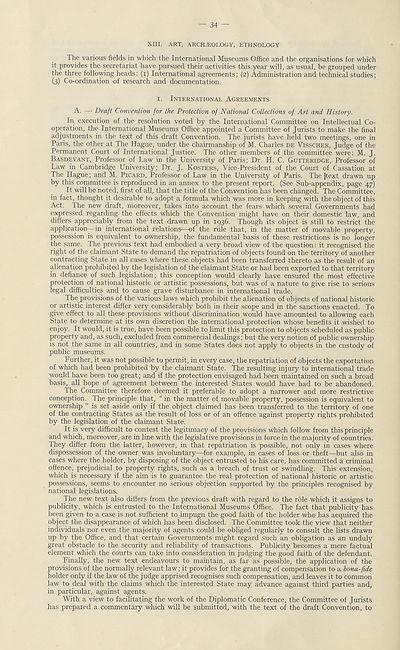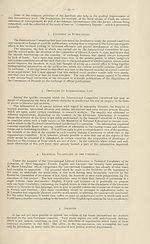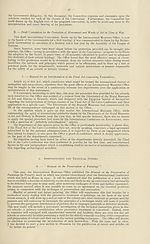International > Report by the committee on the work of its ... plenary session > Twenty first plenary session
(34)
Download files
Complete book:
Individual page:
Thumbnail gallery: Grid view | List view

— 34 —
XIII. ART, ARCHAEOLOGY, ETHNOLOGY
The various fields in which the International Museums Office and the organisations for which
it provides the secretariat have pursued their activities this.year will, as usual, be grouped under
the three following heads: (i) International agreements; (2) Administration and technical studies;
(3) Co-ordination of research and documentation.
1. International Agreements
A. — Draft Convention for the Protection of National Collections of Art and History.
In execution of the resolution voted by the International Committee on Intellectual Co¬
operation, the International Museums Office appointed a Committee of Jurists to make the final
adjustments in the text of this draft Convention. The jurists have held two meetings, one in
Paris, the other at The Hague, under the chairmanship of M. Charles de Visscher, Judge of the
Permanent Court of International Justice. The other members of the committee were: M. J.
Basdevant, Professor of Law in the University of Paris; Dr. H. C. Gutteridge, Professor of
Law in Cambridge University; Dr. J. Rosters, Vice-President of the Court of Cassation at
The Hague; and M. Picard, Professor of Law in the University of Paris. The (text drawn up
by this committee is reproduced in an annex to the present report. (See Sub-appendix, page 47)
It will be noted, first of all, that the title of the Convention has been changed. The Committee,
in fact, thought it desirable to adopt a formula which was more in keeping with the object of this
Act. The new draft, moreover, takes into account the fears which several Governments had
expressed regarding the effects which the Convention might have on their domestic law, and
differs appreciably from the text drawn up in 1936. Though its object is still to restrict the
application—in international relations—of the rule that, in the matter of movable property,
possession is equivalent to ownership, the fundamental basis of these restrictions is no longer
the same. The previous text had embodied a very broad view of the question: it recognised the
right of the claimant State to demand the repatriation of objects found on the territory of another
contracting State in all cases where these objects had been transferred thereto as the result of an
alienation prohibited by the legislation of the claimant State or had been exported to that territory
in defiance of such legislation; this conception would clearly have ensured the most effective
protection of national historic or artistic possessions, but was of a nature to give rise to serious
legal difficulties and to cause grave disturbance in international trade.
The provisions of the various laws which prohibit the alienation of objects of national historic
or artistic interest differ very considerably both in their scope and in the sanctions enacted. To
give effect to all these provisions without discrimination would have amounted to allowing each
State to determine at its own discretion the international protection whose benefits it wished to
enjoy. It would, it is true, have been possible to limit this protection to objects scheduled as public
property and, as such, excluded from commercial dealings; but the very notion of public ownership
is not the same in all countries, and in some States does not apply to objects in the custody of
public museums.
Further, it was not possible to permit, in every case, the repatriation of objects the exportation
of which had been prohibited by the claimant State. The resulting injury to international trade
would have been too great; and if the protection envisaged had been maintained on such a broad
basis, all hope of agreement between the interested States would have had to be abandoned.
Ihe Committee therefore deemed it preferable to adopt a narrower and more restrictive
conception. The principle that, “ in the matter of movable property, possession is equivalent to
ownership ” is set aside only if the object claimed has been transferred to the territory of one
of the contracting States as the result of loss or of an offence against property rights prohibited
by the legislation of the claimant State.
It is very difficult to contest the legitimacy of the provisions which follow from this principle
and which, moreover, are in line with the legislative provisions in force in the majority of countries.
They differ from the latter, however, in that repatriation is possible, not only in cases where
dispossession of the owner was involuntary—for example, in cases of loss or theft—but also in
cases where the holder, by disposing of the object entrusted to his care, has committed a criminal
offence, prejudicial to property rights, such as a breach of trust or swindling. This extension,
which is necessary if the aim is to guarantee the real protection of national historic or artistic
possessions, seems to encounter no serious objection supported by the principles recognised by
national legislations.
The new text also differs from the previous draft with regard to the role which it assigns to
publicity, which is entrusted to the International Museums Office. The fact that publicity has
been given to a case is not sufficient to impugn the good faith of the holder who has acquired the
object the disappearance of which has been disclosed. The Committee took the view that neither
individuals nor even the majority of agents could be obliged regularly to consult the lists drawn
up by the Office, and that certain Governments might regard such an obligation as an unduly
great obstacle to the security and reliability of transactions. Publicity becomes a mere factual
element which the courts can take into consideration in judging the good faith of the defendant.
Finally, the new text endeavours to maintain, as far as possible, the application of the
provisions of the normally relevant law; it provides for the granting of compensation to a bona-fide
holder only if the law of the judge apprised recognises such compensation, and leaves it to common
law to deal with the claims which the interested State may advance against third parties and,
in particular, against agents.
With a view to facilitating the work of the Diplomatic Conference, the Committee of Jurists
has prepared a commentary which will be submitted, with the text of the draft Convention, to
XIII. ART, ARCHAEOLOGY, ETHNOLOGY
The various fields in which the International Museums Office and the organisations for which
it provides the secretariat have pursued their activities this.year will, as usual, be grouped under
the three following heads: (i) International agreements; (2) Administration and technical studies;
(3) Co-ordination of research and documentation.
1. International Agreements
A. — Draft Convention for the Protection of National Collections of Art and History.
In execution of the resolution voted by the International Committee on Intellectual Co¬
operation, the International Museums Office appointed a Committee of Jurists to make the final
adjustments in the text of this draft Convention. The jurists have held two meetings, one in
Paris, the other at The Hague, under the chairmanship of M. Charles de Visscher, Judge of the
Permanent Court of International Justice. The other members of the committee were: M. J.
Basdevant, Professor of Law in the University of Paris; Dr. H. C. Gutteridge, Professor of
Law in Cambridge University; Dr. J. Rosters, Vice-President of the Court of Cassation at
The Hague; and M. Picard, Professor of Law in the University of Paris. The (text drawn up
by this committee is reproduced in an annex to the present report. (See Sub-appendix, page 47)
It will be noted, first of all, that the title of the Convention has been changed. The Committee,
in fact, thought it desirable to adopt a formula which was more in keeping with the object of this
Act. The new draft, moreover, takes into account the fears which several Governments had
expressed regarding the effects which the Convention might have on their domestic law, and
differs appreciably from the text drawn up in 1936. Though its object is still to restrict the
application—in international relations—of the rule that, in the matter of movable property,
possession is equivalent to ownership, the fundamental basis of these restrictions is no longer
the same. The previous text had embodied a very broad view of the question: it recognised the
right of the claimant State to demand the repatriation of objects found on the territory of another
contracting State in all cases where these objects had been transferred thereto as the result of an
alienation prohibited by the legislation of the claimant State or had been exported to that territory
in defiance of such legislation; this conception would clearly have ensured the most effective
protection of national historic or artistic possessions, but was of a nature to give rise to serious
legal difficulties and to cause grave disturbance in international trade.
The provisions of the various laws which prohibit the alienation of objects of national historic
or artistic interest differ very considerably both in their scope and in the sanctions enacted. To
give effect to all these provisions without discrimination would have amounted to allowing each
State to determine at its own discretion the international protection whose benefits it wished to
enjoy. It would, it is true, have been possible to limit this protection to objects scheduled as public
property and, as such, excluded from commercial dealings; but the very notion of public ownership
is not the same in all countries, and in some States does not apply to objects in the custody of
public museums.
Further, it was not possible to permit, in every case, the repatriation of objects the exportation
of which had been prohibited by the claimant State. The resulting injury to international trade
would have been too great; and if the protection envisaged had been maintained on such a broad
basis, all hope of agreement between the interested States would have had to be abandoned.
Ihe Committee therefore deemed it preferable to adopt a narrower and more restrictive
conception. The principle that, “ in the matter of movable property, possession is equivalent to
ownership ” is set aside only if the object claimed has been transferred to the territory of one
of the contracting States as the result of loss or of an offence against property rights prohibited
by the legislation of the claimant State.
It is very difficult to contest the legitimacy of the provisions which follow from this principle
and which, moreover, are in line with the legislative provisions in force in the majority of countries.
They differ from the latter, however, in that repatriation is possible, not only in cases where
dispossession of the owner was involuntary—for example, in cases of loss or theft—but also in
cases where the holder, by disposing of the object entrusted to his care, has committed a criminal
offence, prejudicial to property rights, such as a breach of trust or swindling. This extension,
which is necessary if the aim is to guarantee the real protection of national historic or artistic
possessions, seems to encounter no serious objection supported by the principles recognised by
national legislations.
The new text also differs from the previous draft with regard to the role which it assigns to
publicity, which is entrusted to the International Museums Office. The fact that publicity has
been given to a case is not sufficient to impugn the good faith of the holder who has acquired the
object the disappearance of which has been disclosed. The Committee took the view that neither
individuals nor even the majority of agents could be obliged regularly to consult the lists drawn
up by the Office, and that certain Governments might regard such an obligation as an unduly
great obstacle to the security and reliability of transactions. Publicity becomes a mere factual
element which the courts can take into consideration in judging the good faith of the defendant.
Finally, the new text endeavours to maintain, as far as possible, the application of the
provisions of the normally relevant law; it provides for the granting of compensation to a bona-fide
holder only if the law of the judge apprised recognises such compensation, and leaves it to common
law to deal with the claims which the interested State may advance against third parties and,
in particular, against agents.
With a view to facilitating the work of the Diplomatic Conference, the Committee of Jurists
has prepared a commentary which will be submitted, with the text of the draft Convention, to
Set display mode to:
![]() Universal Viewer |
Universal Viewer | ![]() Mirador |
Large image | Transcription
Mirador |
Large image | Transcription
Images and transcriptions on this page, including medium image downloads, may be used under the Creative Commons Attribution 4.0 International Licence unless otherwise stated. ![]()
| League of Nations > International > Report by the committee on the work of its ... plenary session > Twenty first plenary session > (34) |
|---|
| Permanent URL | https://digital.nls.uk/195386495 |
|---|
| Attribution and copyright: |
|
|---|---|
| Shelfmark | LN.XII.5 |
|---|---|
| Shelfmark | LN.XII |
|---|
| Description | Over 1,200 documents from the non-political organs of the League of Nations that dealt with health, disarmament, economic and financial matters for the duration of the League (1919-1945). Also online are statistical bulletins, essential facts, and an overview of the League by the first Secretary General, Sir Eric Drummond. These items are part of the Official Publications collection at the National Library of Scotland. |
|---|---|
| Additional NLS resources: |
|

